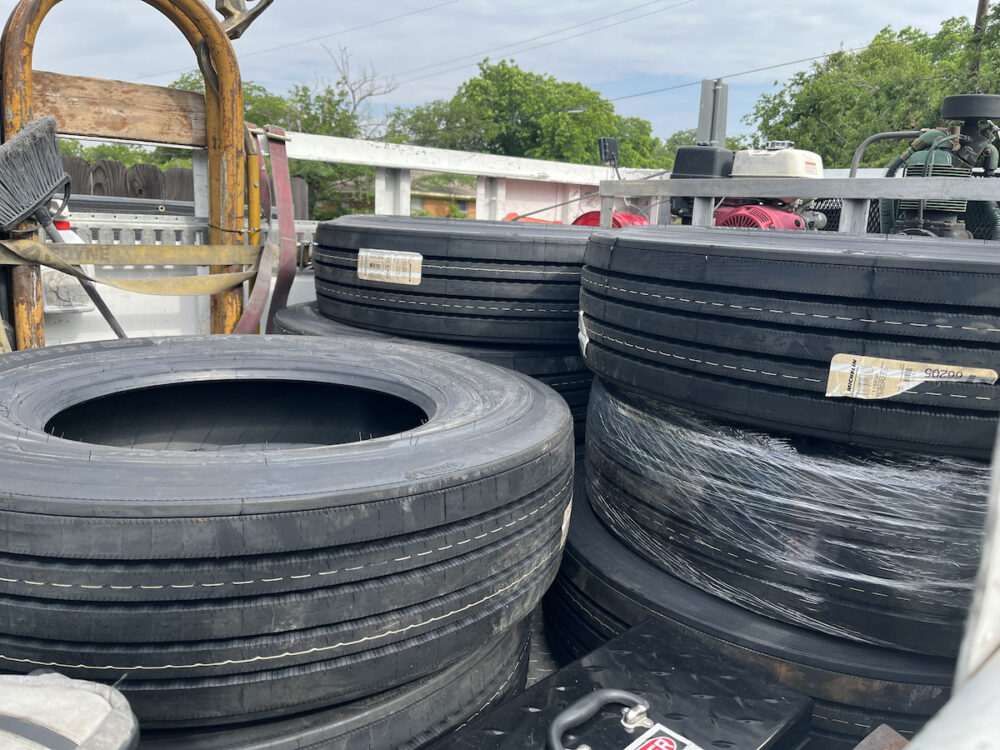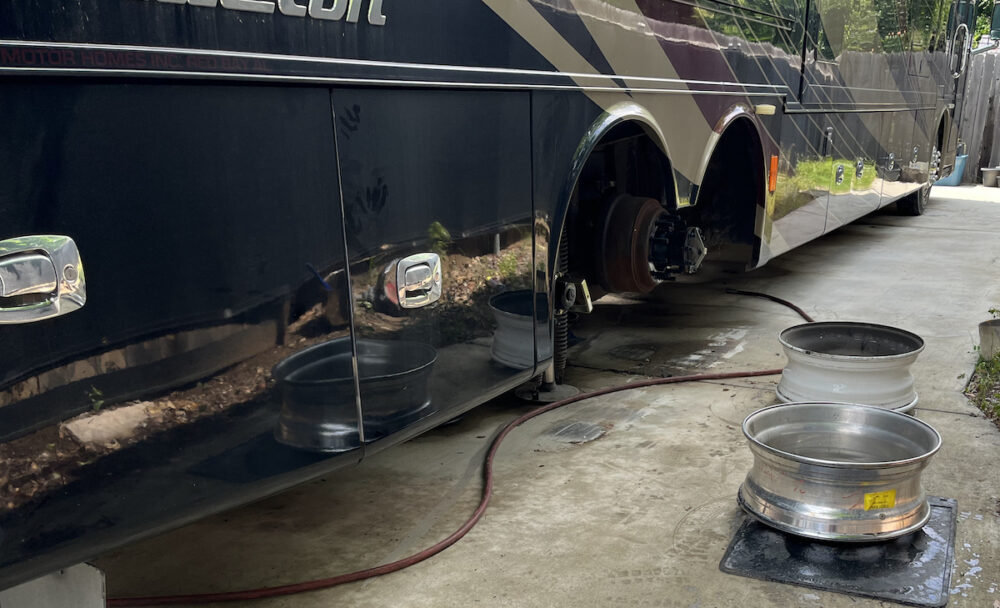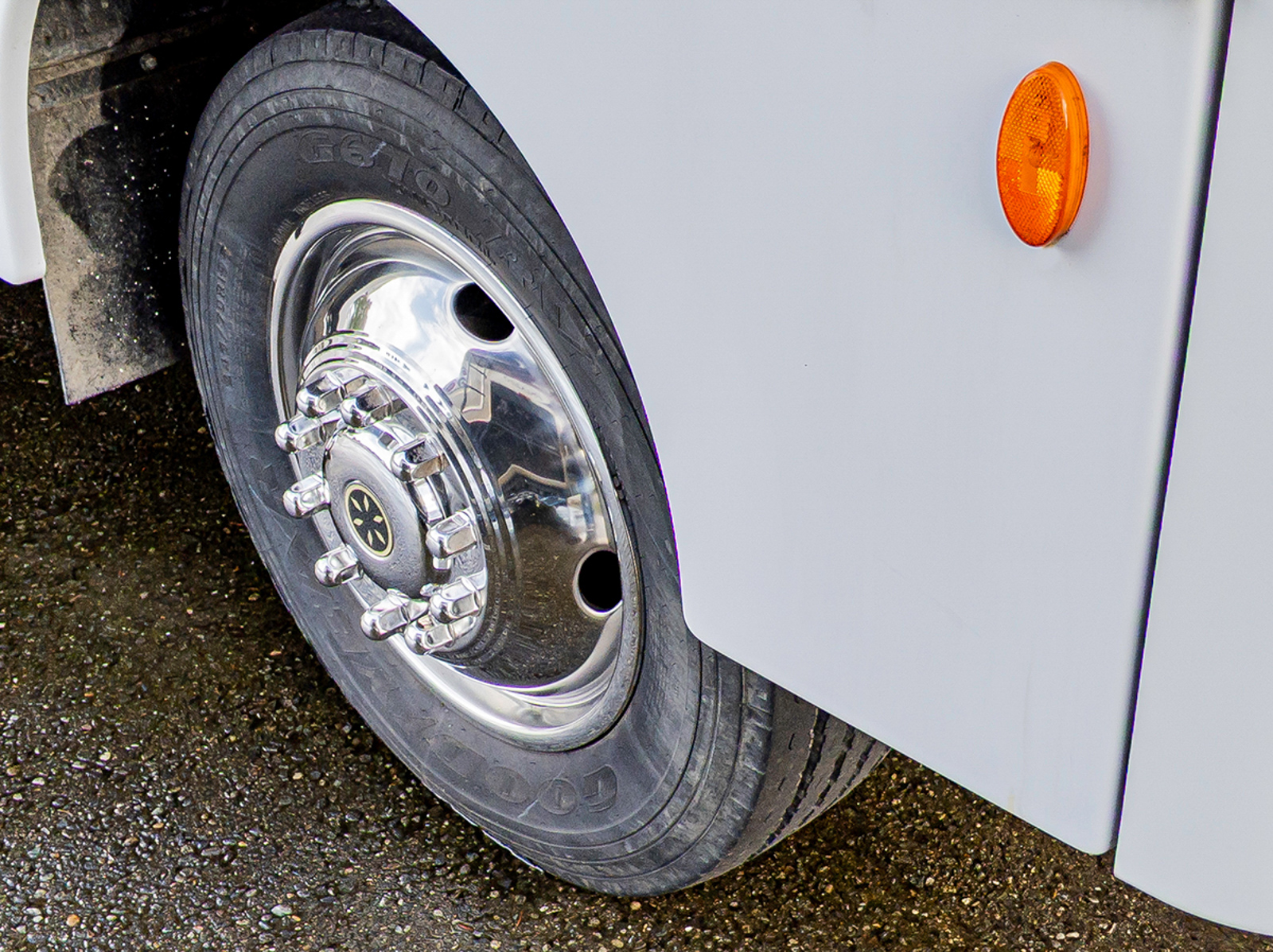
In partnership with MotorhomeTires.com
Here’s How The Mobile RV Tire Replacement For My Coach Went Down
Having a motorhome is great, but it can get expensive. I’m awfully protective of our coach as well, so I do everything I can possibly do on my own to save costs and heartache. Putting on new tires isn’t one of them, but through MotorhomeTires.com, I was able to do the next best thing: have them replaced at my home where my coach is parked, courtesy of the mobile RV tire replacement that Motorhome Tires provides with every installation.
Almost a full year after I decided my motorhome needed new tires, I finally got it done. We didn’t travel as much last year as I had hoped, and I reached a point this year where I could not in good conscience roll on the tires I had, with a date code from 2014.
While cost is always a factor when making any decision on the coach, this was a safety choice. When I initially thought about new tires, I hadn’t even considered mobile RV tire replacement. My assumption was that my lovely coach would be taken to some corner of a big 18-wheeler shop and presumably roll back with new rubber and no damage.
I had already had a bad experience with my local heavy chassis shop scratching the fiberglass rear cap on my coach. Though it was near the bottom and easy enough to touch-up, it was about a foot long and easy to see. I was hesitant to return there. Fortunately, I had learned about Motorhome Tires and their mobile RV tire replacement.
Preparing for a mobile RV tire replacement
In preparing to get eight new tires on the coach, I had very little to do on my end, other than ensuring I had at least three feet of clearance on either side of the coach. On the concrete slab I have, we actually have four feet on either side, so I was good to go. The real work came from the team at Motorhome Tires. They warned me there would be a lot of communication—and there was. Emails, phone calls, and text messages kept me apprised of the status of my tires at all times.
The new tires were shipped directly to the installer, as were any additional parts—in this case, valve stem extenders and balance beads. This was all communicated to me regularly as needed, so I never had to wonder exactly where I was in the process. The day before the mobile RV tire replacement, I removed my tire covers. I had already removed my TPMS sensors the last time I parked it earlier in the year. They had advised me that the installers would call me around 9:00 a.m. the following morning.
Installation day
The next morning, I unlocked the double-gate and moved the Jeep to ensure the mobile installers could back up to the coach as closely as they needed. At 9:03 a.m., the installers called and said they were on their way, even asking in a friendly way, “Are you ready for some new tires on your coach?” It’s a little thing, but it already felt like they really cared.
The installers arrived a bit later, laden with eight fresh new tires. In order to facilitate the mobile RV tire replacement, they had me raise the front end slightly with the leveling jacks, just enough for the wheel well to clear the tires, as the airbags were depleted, of course. This also made it easier for them to get their jacks and safety stands under the motorhome. I would do the same for the rear later.
Their first course of action was to unload the new tires. The new 275/80R22.5 Michelin Xline Energy Z 16-ply tires weigh about 110 lbs each, so having a lift on the truck was essential. The truck the guys brought with them was typical of what you would expect to see on the side of the highway fixing an 18-wheeler flat, only carrying a lot more tires!
The mobile RV tire replacement
The actual installation of all eight tires took a while, about three and a half hours. Throughout the process, I tried to get some pictures, a few which you see here, but I also didn’t want to be in the way.
There is no tire machine like you’ll find at your local automobile tire store; these guys have to break the bead and pry the tires off with long tire tools. They laid down rubber mats on the concrete to protect the wheel when doing this. There is no balancing machine either; the installers dumped a 10.5 oz bag of Magnum Plus balance beads into each tire.

Tire inflation fine-tuning
After the mobile RV tire replacement was complete and the technicians were on their way, I washed each tire and wheel and set the inflation levels I knew were appropriate for my coach, using a Michelin inflation chart. I’ve weighed my coach three times, each time fully loaded, and my numbers were consistent. My required psi remained unchanged, in that my two front steer tires required 105 psi, while the six rear tires all settled in at 90 psi, though in truth I could run them with less than that, and I could safely push them down to 85 psi for a bit softer ride.
When using inflation charts like this, it’s important to take your time and make sure you are looking at the right tire size with the correct load range. There is a lot there, and it’s easy to look at the wrong column. As always, I recommend a TPMS system to always be tracking your tire pressure. Aside from a direct puncture, most tire failures occur due to underinflation and thus overheating. Correct tire pressure is critical.
Rating the mobile RV tire installation
With mobile RV tire replacement, there is no better way to get new tires on your coach. Nothing happens behind the scenes where you can’t see it, and you don’t have to take your coach and hang around a truck stop or tire shop for four hours.
The tire technicians that came to my house were friendly and knowledgeable and prepared for anything—broken studs, valve rebuilds—whatever they needed. Motorhome Tires has tapped into some secret sauce here, and I’m happy to say I’m good to go for another seven years or so.




thank you for the overview. I have wondered about the balancing process and how that stacks up.
Nice story for you, I noticed you did not mention if they performed a front tire runout I’ll explain when the tire beads up it is always off out of round I’ve always dropped the air pressure to zero and then reinfaited the fronts several times and use a tool to check for roundness just saying over twenty years in the business of replacing heavy truck tires this was always performed